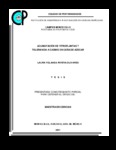| dc.description.abstract | En un primer experimento se evaluó la aclimatación de vitroplantas de caña de azúcar de las variedades MEX69290 y CP722086 en tres sustratos; 1) TBZ: tezontle + bagazo de caña, 2) TCA: Tezontle + cascarilla de arroz y 3) TCZ: tezontle + cachaza; las mezclas en éstos en una proporción 40/60 (v/v). Las variables evaluadas fueron porcentaje de sobrevivencia, altura de plántula, diámetro de tallo, biomasa seca, azúcares solubles totales y concentración nutrimental. Las últimas tres variables fueron evaluadas en los vástagos y raíces. Se utilizó un diseño experimental completamente al azar con cincuenta repeticiones por tratamiento. A los 30 d, la menor sobrevivencia de la variedad MEX69290 fue de 84%;, mientras que la de CP722086 de 64%; en ambos casos en el sustrato TCZ. La mayor sobrevivencia (98%) se presentó en el sustrato TCA para ambas variedades, así como en TBZ para MEX69290. El sustrato conteniendo cascarilla de arroz en combinación con la variedad CP722086 tuvieron los valores más altos en las variables de crecimiento. Por el contrario, la mayor concentración de nutrimentos de manera general fue observada en la variedad MEX69290, siendo evidente el efecto de dilución. La concentración de carbohidratos tanto en raíces como en vástago no presentó diferencias estadísticas por factores de estudio, ni por la interacción de éstos. Los resultados permiten concluir que la cascarilla de arroz en combinación con tezontle es una alternativa viable y de bajo costo, para la aclimatación de plántulas de caña de azúcar. En un segundo experimento se evaluó el efecto de la adición de 0 y 1 mM de Cd en la solución nutritiva (Steiner al 10%) sobre la concentración nutrimental final de los vástagos en plantas de caña de azúcar. En este ensaño se evaluaron las mezclas de sustratos antes descritas y un cuarto sustrato consistente sólo en tezontle. Se utilizaron plantas de la variedad CP722086 en un factorial (factores: Cd y sustrato), completamente al azar con cuatro repeticiones por tratamiento. Las concentraciones de N, P, Fe, Zn, Mn, B y Na no fueron afectadas por la adición de Cd a la solución nutritiva, mientras que la adición de 1 mM afectó positivamente las concentraciones de Ca y Mg; por el contrario, el Cd redujo las concentraciones de K. El factor sustrato, sólo no afectó en forma significativa las concentraciones de Ca, Zn, B y Na en vástago. Con excepción de Na, la interacción de los factores de estudio tuvo efectos significativos sobre la concentración de los elementos en el vástago. Los resultados permiten concluir que la caña de azúcar es una especie que tolera una concentración de Cd de 1 mM, en particular cuando es establecida en sustratos conteniendo cachaza. _______________ ACCLIMATIZATION OF PLANTLETS AND CADMIUM TOLERANCE IN SUGAR CANE. ABSTRACT: In a first experiment, the acclimatization of sugarcane plantlets of the varieties and CP722086 and MEX69290 in three substrates mixtures (in a 40/60 ratio v/v): 1) TBZ: tezontle + bagasse, 2) TCA: tezontle + rice husk and 3) TCZ: tezontle + mill mud (filter cake, cachaza), were evaluated. The variables studied were: percentage of survival, seedling height, stem diameter, dry biomass, total soluble sugars and nutrient concentration. Last three variables were evaluated in stems and roots. A completely randomized design with 50 replicates per treatment was used. At day 30 after treatment (dat), the lowest survival in the variety MEX69290 was 84%, while that for CP722086 was at least 64%, in both cases in the substrate TCZ. The survival (98%) occurred in the TCA substrate for both varieties, as well as in TBZ for MEX69290. The substrate containing rice husk in combination with the variety CP722086 had the highest values in the variables of growth. By contrast, the highest concentration of nutrients was observed generally in the variety MEX69290, evidencing the effect of dilution. The carbohydrate concentration in roots and stem did not present statistical differences by any factor of study or by the interaction of them. The results suggest that rice husk in combination with tezontle is a viable, low cost substrate for the acclimatization of sugarcane plantlets. In a second experiment the effect of the addition of 0 and 1 mM Cd in the nutrient solution (Steiner 10%) on the final nutrient concentration in stems of sugarcane plants was evaluated. Besides the three substrates before indicated, a fourth substrate consisting only of tezontle was tested too. Plants of the variety CP722086 in a factorial experiment (factors: Cd and substrate) in a completely randomized design with four replicates per treatment were tested. The concentrations of N, P, Fe, Zn, Mn, B and Na were not affected by the addition of Cd to the nutrient solution, while the addition of 1 mM Cd positively affected Ca and Mg concentrations. On the contrary, Cd reduced K concentration. The factor substrate, just did not significantly affect the stem concentrations of Ca, Zn, B and Na in stem. With the exception of Na, the interaction between had significant effects on the concentration of elements in the stem. The results suggest that sugar cane is a species that tolerates a concentration of 1 mM Cd, particularly when it is established on substrates containing mill mud. | es |


